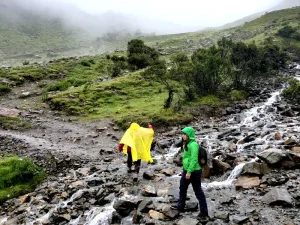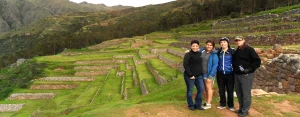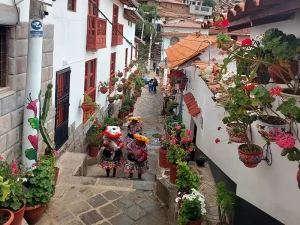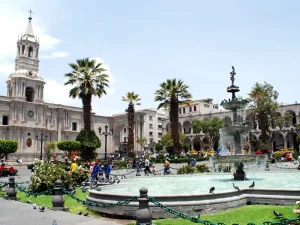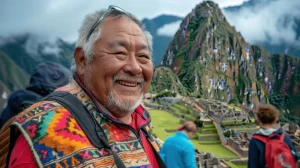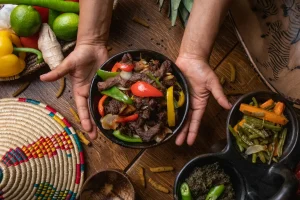Imagine standing in the ancient stone courtyard of Qorikancha, the Temple of the Sun in Cusco. The first rays of dawn illuminate the intricate stonework, and the air thrums with anticipation. Around you, a crowd gathers—locals with weathered, smiling faces, travelers clutching cameras with reverent excitement. Then, you hear it: a deep, resonant blast from a pututu (a traditional Andean conch shell trumpet). The Inca Priest raises his arms to the sky, his voice echoing in Quechua as he offers a prayer to Inti, the Sun God. You feel goosebumps—not from the morning chill, but from the palpable energy of a ritual that has transcended centuries. This isn’t just a performance; it’s a living, breathing connection to the soul of Peru.
This is the magic of Peruvian festivities. As a local guide who has grown up with these celebrations woven into the fabric of my life, I invite you to look beyond the tourist brochures. In Peru, festivals are not mere events; they are the heartbeat of our communities, the vibrant threads that weave together our ancient Indigenous roots, our complex Spanish colonial history, and our modern, dynamic identity. With over 3,000 festivals celebrated across the country each year, there is always a reason to dance, pray, and feast . This article is your insider’s guide to the most important ones—a journey through time, faith, and unbridled joy.
Where Celebration Meets the Andes Spirit
When you arrive in Peru, you don’t just step into a country—you step into a living mosaic of traditions, colors, and ancestral wisdom. As a local guide born in Cusco, I often tell my travelers that in Peru, every month feels like a festival. From the sacred rituals of the Incas to the lively dances of the Andes and the mystical processions of Catholic faith, celebrations are not just events—they are a way of life.
Imagine yourself walking through a cobblestone street in Cusco during Inti Raymi, surrounded by dancers in bright costumes, their movements echoing ancient rituals to the Sun God. Or picture yourself in Puno during La Virgen de la Candelaria, where music, devotion, and folklore fill the streets for days. These are not just spectacles—they are immersive experiences where history, spirituality, and joy converge.
Let me take you on a journey through Peru’s most important festivities, where every drumbeat and every chant tells the story of who we are as Peruvians.
Why Peru’s Festivities Matter
Festivities in Peru are more than simple parties—they are the threads that weave our diverse cultures together. Here’s why they matter:
- A Living Connection to the Past: Many celebrations are rooted in Inca traditions, later blended with Spanish Catholic influences, creating a unique cultural fusion.
- Identity & Community: Each festival reflects the soul of its people, bringing entire towns together in unity.
- A Feast for the Senses: Dances, costumes, music, food, and rituals make every celebration a multi-sensory experience.
- Traveler’s Dream: For visitors, festivals provide a chance to see authentic Peru—not the one in guidebooks, but the one lived by locals.
The Historical & Cultural Tapestry of Celebration
Understanding our festivals requires a glimpse into our past. The Inca civilization, the largest and most sophisticated in pre-Columbian America, was deeply spiritual and organized its calendar around astronomical events and agricultural cycles. Festivals like Inti Raymi were state-sponsored events crucial for ensuring fertility, prosperity, and social order.
The Spanish conquest in the 16th century sought to suppress Indigenous religions. Catholicism was imposed, but in a fascinating act of resilience, our ancestors overlaid their ancient beliefs onto the new Catholic saints and holidays. The Virgin Mary was often associated with Pachamama, and Catholic saints were linked to mountain spirits. This created a rich, complex, and uniquely Peruvian blend of traditions that you see today in festivals like the Fiesta de la Candelaria or Qoyllur Rit’i.
Today, this fusion continues to evolve, incorporating modern elements while steadfastly honoring the past.
A Year of Celebration: Peru’s Festival Calendar at a Glance
While there are thousands of local fiestas, here are the most significant ones that deserve a spot on any traveler’s itinerary:
| Festival | Date | Location | Cultural Significance |
| Fiesta de la Candelaria | February 2-11 | Puno | One of South America’s largest festivals; honors the Virgin of Candelaria with massive dance troupes. |
| Carnival de Cajamarca | February (Pre-Lent) | Cajamarca | Peru’s most famous Carnival celebration, known for its water fights and lively parades. |
| Inti Raymi | June 24 | Cusco | The magnificent Inca Festival of the Sun, a massive historical reenactment. |
| Qoyllur Rit’i | Late May / Early June (before Corpus Christi) | Sinakara Valley, Cusco | One of the largest Indigenous pilgrimages in the Americas, blending Catholic and Andean beliefs. |
| Fiesta de la Virgen del Carmen | July 15-17 | Paucartambo, Cusco | A dramatic and colorful festival featuring intricate masked dances. |
| Independence Day (Fiestas Patrias) | July 28-29 | Nationwide, best in Lima | Celebrates Peru’s independence with military parades, folk music, and national pride. |
| Señor de los Milagros | October | Lima | A massive month-long procession of a revered Christ painting, a key event for Afro-Peruvian communities. |
| Puno Week | First week of November | Puno | Commemorates the legendary birth of the first Inca, Manco Cápac, from Lake Titicaca. |
| Santuranticuy | December 24 | Cusco | A traditional Christmas Eve market for buying saints and figurines for nativity scenes. |
History & Cultural Roots of Peruvian Festivities
Peruvian celebrations are a mirror of our history. Before the Spanish conquest, the Inca Empire honored deities of nature—like Inti (the Sun), Pachamama (Mother Earth), and the Apus (sacred mountains). Rituals were tied to agricultural cycles, harvests, and cosmic events.
With the arrival of the Spanish in the 16th century, Catholicism intertwined with Andean traditions. Saints replaced some gods, and processions mixed with ancient dances. But instead of erasing our roots, this blending gave birth to something extraordinary: syncretism, a harmonious coexistence of two worlds.
Today, Peru has more than 3,000 festivals a year, making it one of the most festive countries on Earth.
The Most Important Festivities in Peru
1. Inti Raymi – Festival of the Sun (Cusco)
- When: June 24
- Where: Cusco, the historic capital of the Inca Empire
As a Cusqueño guide, this is the festival closest to my heart. Inti Raymi was the Inca Empire’s most sacred ritual, dedicated to Inti, the Sun God. Today, it is reenacted with grandeur.
You’ll see a majestic procession starting from Qorikancha (Temple of the Sun) to the fortress of Sacsayhuamán. Actors dressed as Inca priests, nobles, and the Sapa Inca himself recreate the ceremony, accompanied by music and dances that transport you back to the 15th century.
Traveler’s Tip: Arrive early at Sacsayhuamán and book your tickets in advance. The view of the Inca Emperor raising his arms to the sun is something you’ll never forget.
2. Virgen de la Candelaria (Puno)
- When: February (first two weeks)
- Where: Puno, on the shores of Lake Titicaca
Declared by UNESCO as Intangible Cultural Heritage of Humanity, this is one of the largest folkloric festivals in South America. It blends Catholic devotion with Andean dance and music.
Over 40,000 dancers and 9,000 musicians flood Puno’s streets, performing traditional dances like the Diablada (Dance of the Devils) and the Morenada. It’s a carnival of colors, feathers, masks, and devotion to the Virgin Mary, who is believed to protect the miners and the city.
Traveler’s Tip: Be prepared for altitude (3,800 meters). Drink coca tea or chew coca leaves to adapt.
3. Carnaval (Cajamarca & Beyond)
- When: February/March, before Lent
- Where: Cajamarca is the heart of Peruvian Carnival
If you love joy, laughter, and water fights, Carnival is for you. Cajamarca becomes a playground where locals and travelers join in paint battles, parades, and dances. Traditional “coplas” (humorous verses) are sung, and people dress in colorful costumes, spreading good vibes everywhere.
Other regions like Cusco and Ayacucho also celebrate with yunzas (trees decorated with gifts, which participants try to cut down).
Traveler’s Tip: Wear clothes you don’t mind getting wet or painted. Bring your best smile—Carnival is all about fun!
4. Señor de los Milagros (Lord of Miracles – Lima)
- When: October
- Where: Lima
Known as the largest Catholic procession in the world, Señor de los Milagros brings together thousands dressed in purple, walking through Lima’s streets in devotion to a miraculous image of Christ painted by an enslaved Angolan in the 17th century.
The air fills with incense, prayers, and traditional food like turrón de Doña Pepa, a sweet treat sold only during this month.
Traveler’s Tip: If you’re in Lima in October, wear purple and join the faithful—it’s a unique way to feel the city’s spiritual heartbeat.
5. Corpus Christi (Cusco)
- When: June (date varies, 60 days after Easter)
- Where: Cusco
Fifteen saints and virgins are carried in elaborate processions from different churches to Cusco’s Plaza de Armas. This tradition merges Inca rituals of bringing mummies of ancestors to the main square with Catholic devotion.
It’s also the time to try chiriuchu, a traditional dish made of guinea pig, chicken, sausage, and corn.
6. Qoyllur Rit’i – Snow Star Festival (Sinakara Valley, Cusco)
- When: Late May or early June
- Where: Sinakara Valley, near Ausangate Mountain
This is one of the most profound and authentic spiritual journeys you can witness in the Americas. It takes place at a glacier-lined shrine at over 4,700 meters (15,420 ft) above sea level. Tens of thousands of pilgrims, mostly Indigenous Quechua people, undertake an arduous trek to the sacred Mount Sinakara.
- The Spiritual Blend: The festival honors a vision of Christ that appeared to a local boy, but it is deeply interwoven with worship of the Apus (mountain spirits). The main participants are the ukukus (men dressed as mythical half-bear creatures), who are the spiritual guardians of the event. They ascend the glaciers to collect sacred ice, which is believed to have healing properties and will melt to water the communities’ lands.
- How to Approach It: This is a pilgrimage, not a tourist event. Go with a respectful, small tour operator or guide who understands the cultural sensitivities. Be prepared for extreme cold, high altitude, and basic conditions. Your reward is an unparalleled glimpse into living Andean spirituality.
7. Fiesta de la Vendimia (Ica)
- When: March
- Where: Ica, the land of vineyards
This is Peru’s wine and pisco harvest festival. Visitors enjoy grape-stomping, parades, music, and of course, tastings of Peru’s famous pisco sour.
Authentic Experiences Beyond the Festivals
Festivals are more than parades—they are living classrooms of culture. During them, you can:
- Taste regional dishes like pachamanca, anticuchos, or cuy.
- See handmade costumes embroidered with sequins and feathers.
- Join locals in traditional dances, even if you don’t know the steps.
- Learn about Andean cosmovision—the respect for Pachamama and the Apus.
The Practical Guide: Attending Festivals Like a Local
Best Time to Visit & Weather
Peru’s festival year never stops, but the dry season (April to October) is ideal for travel, coinciding with major events like Inti Raymi and Fiestas Patrias. Remember:
- Andes (Cusco, Puno): Days are sunny, nights are cold (can drop to 0°C/32°F). Always have layers.
- Coast (Lima): Often overcast and humid, even in summer. A jacket is essential.
Getting There & Around
- Major Hubs: Fly into Lima (LIM), then take a domestic flight to Cusco (CUZ) or Juliaca (JUL) for Puno.
- Local Transport: For festivals, buses get packed and roads can be closed. Plan to arrive in the city at least two days early. For events in remote towns like Paucartambo, booking a private tour with transport is often the most reliable option.
Accommodations
- Book far in advance! For major festivals, hotels can be fully booked 6-12 months ahead. Prices also surge dramatically.
- Consider staying in nearby towns and commuting if possible, but factor in road closures.
What to Pack & Wear
- Layers are key: Thermal wear, fleece, waterproof jacket, hat, gloves for high-altitude events.
- Comfortable footwear: You will be standing and walking for hours.
- Daypack: Water, sunscreen, sunglasses, snacks, cash (ATMs run out), and toilet paper.
- Respectful clothing: For religious processions, avoid shorts and sleeveless tops.
Safety & Etiquette
- Altitude Sickness: Spend 2-3 days acclimatizing in Cusco before any strenuous activity. Drink coca tea and stay hydrated.
- Pickpocketing: Crowds are prime targets. Use a money belt and keep your bag in front of you.
- Cultural Respect: Ask before taking photos of people, especially during solemn religious moments. Participate with a smile and respectful curiosity.
Best Time to Visit Peru for Festivals
- January–March: Carnival, Candelaria, Vendimia
- June: Inti Raymi, Corpus Christi, Qoyllur Rit’i
- October: Señor de los Milagros
- Year-round: Local fiestas patronales in villages
Tip: Align your trip with a major festival, but book accommodation early—towns get fully packed.
Travel Tips for Enjoying Festivals in Peru
- Altitude prep: Many festivals happen in the Andes. Acclimatize gradually.
- What to pack: Comfortable shoes, layers, sunscreen, water, and festive spirit.
- Safety: Festivals are crowded; keep valuables safe.
- Respect: Ask before taking close-up photos of locals in costume.
Comparison with Other Latin American Festivals
While Brazil’s Carnival or Mexico’s Day of the Dead are world-famous, Peru’s celebrations are unique because they fuse Inca traditions, Catholic rituals, and Andean identity. Few places in the world offer such a profound cultural blend.
Frequently Asked Questions (FAQs)
What is the biggest festival in Peru?
Inti Raymi in Cusco and Virgen de la Candelaria in Puno are the largest and most spectacular.
Do I need tickets for Inti Raymi?
Yes, especially for the main ceremony at Sacsayhuamán. Book early.
Is it safe to join local festivals?
Absolutely. Just watch your belongings and enjoy responsibly.
Can tourists participate in the dances?
Some festivals welcome visitors to join in, especially during Carnival.
What food should I try during festivals?
Don’t miss turrón de Doña Pepa in October, chiriuchu in June, and pisco in March.
Conclusion: Celebrate Life the Peruvian Way
In Peru, every festival is a story—of ancestors, faith, joy, and resilience. Whether you’re watching the Inca Emperor salute the sun in Cusco, dancing with masked devils in Puno, or savoring wine in Ica, you are not just a spectator—you become part of the story. So, when you plan your journey, don’t just visit Peru—celebrate Peru. Let the colors, music, and spirit of our festivities guide your adventure. And if you’d like, join me or any local guide—we’ll be proud to show you the heart of our land through its most beautiful celebrations.

